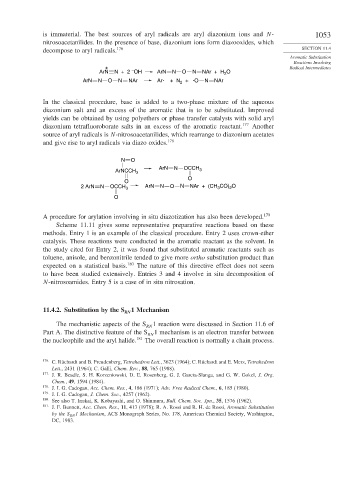Page 1077 - Advanced Organic Chemistry Part B - Reactions & Synthesis
P. 1077
is immaterial. The best sources of aryl radicals are aryl diazonium ions and N- 1053
nitrosoacetanilides. In the presence of base, diazonium ions form diazooxides, which
decompose to aryl radicals. 176 SECTION 11.4
Aromatic Substitution
Reactions Involving
+ Radical Intermediates
–
ArN N + 2 OH ArN N O N NAr + H 2 O
.
.
ArN N O N NAr Ar + N + O N NAr
2
In the classical procedure, base is added to a two-phase mixture of the aqueous
diazonium salt and an excess of the aromatic that is to be substituted. Improved
yields can be obtained by using polyethers or phase transfer catalysts with solid aryl
diazonium tetrafluoroborate salts in an excess of the aromatic reactant. 177 Another
source of aryl radicals is N-nitrosoacetanilides, which rearrange to diazonium acetates
and give rise to aryl radicals via diazo oxides. 178
N O
ArN N
ArNCCH 3 OCCH 3
O
O
2 ArN N OCCH 3 ArN N O N NAr + (CH CO) O
2
3
O
A procedure for arylation involving in situ diazotization has also been developed. 179
Scheme 11.11 gives some representative preparative reactions based on these
methods. Entry 1 is an example of the classical procedure. Entry 2 uses crown-ether
catalysis. These reactions were conducted in the aromatic reactant as the solvent. In
the study cited for Entry 2, it was found that substituted aromatic reactants such as
toluene, anisole, and benzonitrile tended to give more ortho substitution product than
expected on a statistical basis. 180 The nature of this directive effect does not seem
to have been studied extensively. Entries 3 and 4 involve in situ decomposition of
N-nitrosoamides. Entry 5 is a case of in situ nitrosation.
11.4.2. Substitution by the S 1 Mechanism
RN
The mechanistic aspects of the S RN 1 reaction were discussed in Section 11.6 of
Part A. The distinctive feature of the S 1 mechanism is an electron transfer between
RN
the nucleophile and the aryl halide. 181 The overall reaction is normally a chain process.
176
C. Rüchardt and B. Freudenberg, Tetrahedron Lett., 3623 (1964); C. Rüchardt and E. Merz, Tetrahedron
Lett., 2431 (1964); C. Galli, Chem. Rev., 88, 765 (1988).
177 J. R. Beadle, S. H. Korzeniowski, D. E. Rosenberg, G. J. Garcia-Slanga, and G. W. Gokel, J. Org.
Chem., 49, 1594 (1984).
178 J. I. G. Cadogan, Acc. Chem. Res., 4, 186 (1971); Adv. Free Radical Chem., 6, 185 (1980).
179
J. I. G. Cadogan, J. Chem. Soc., 4257 (1962).
180 See also T. Inukai, K. Kobayashi, and O. Shinmura, Bull. Chem. Soc. Jpn., 35, 1576 (1962).
181
J. F. Bunnett, Acc. Chem. Res., 11, 413 (1978); R. A. Rossi and R. H. de Rossi, Aromatic Substitution
by the S RN 1 Mechanism, ACS Monograph Series, No. 178, American Chemical Society, Washington,
DC, 1983.

